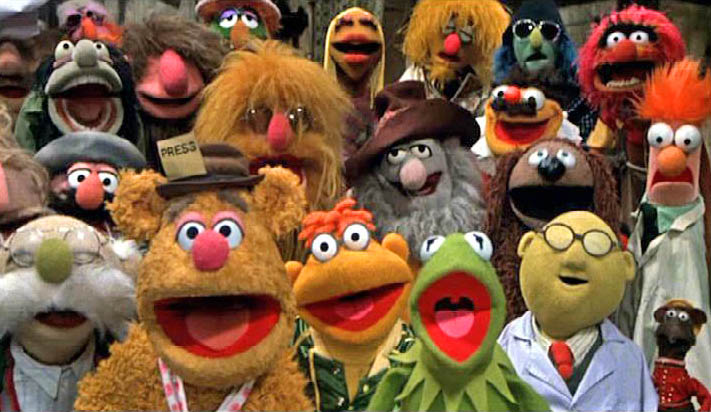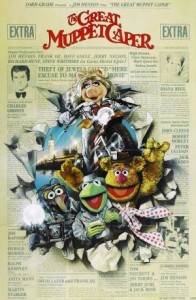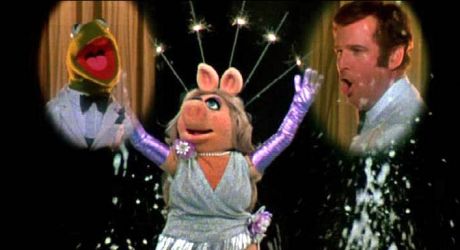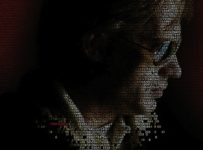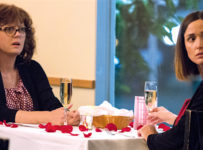Welcome back to 80s Bits, the weekly column in which we explore the best and worst of the Decade of Shame. With guest writers, hidden gems and more, it’s truly, truly, truly outrageous. The Great Muppet Caper is the often overlooked follow-up that doesn’t just acknowledge the fourth wall, but smashes through it.
[stextbox id=”grey” caption=”The Great Muppet Caper (1981)” float=”true” align=”right” width=”200″]
Director: Jim Henson
Runtime: 94 minutes
Starring: Jim Henson, Frank Oz, Jerry Nelson, Richard Hunt, Dave Goelz, Diana Rigg, Charles Grodin
Distributor: Universal (original)/Disney (current)
Country: US
Rating: Highly Recommended (?)

In 1981, Muppet creator Jim Henson decided to end the still successful The Muppet Show to concentrate on feature films. It wasn’t just a pipe dream either. The Muppet’s feature debut, The Muppet Movie (1979), had been welcomed with great financial success, but legitimised the musical theatre aspects of the show with its Golden Globe Award and Academy Award nomination for the anthemic “Rainbow Connection”. So with the freedom and power that a little success grants you, Henson launched The Great Muppet Caper onto an unsuspecting world.
Kermit the Frog, Fozzie Bear and Gonzo are intrepid reporters for the Daily Chronicle, and in a running gag, Kermit and Fozzie are twins that nobody notices until Fozzie wears his hat. After missing one of the biggest stories of the year, the theft of fashion designer Lady Holliday’s (Diana Rigg) jewels, they head off to London to interview her. With no money left, they check into the Happiness Hotel, run by just about every other Muppet we’ve ever met, before Kermit mistakes Miss Piggy for Lady Holliday and a romance ensues. However, when the instant social-hit of Piggy is accused of being the jewel thief by Lady Holliday’s brother Nicky (Charles Grodin), the gang must rally together.
Described as a “mystery comedy”, The Great Muppet Caper builds upon the meta-fictional approach taken by The Muppet Movie‘s film-within-a-film. With this follow-up, Henson doesn’t just acknowledge the fourth wall, but bursts right through it, tramples it to the ground and dances on its rubble remains. Floating through the opening credits in a hot-air balloon, Gonzo remarks “Gee, a lot of people worked on this movie!” to which Kermit replies knowingly “Oh, this is nothing. Wait till you see the end credits”. Later, when Kermit tries to extract himself from a conversation with Peter Falk (playing a tramp in the park), he remarks “I hate to be rude, but we’re trying to do a movie here”. Even Sesame Street’s Oscar the Grouch pops up in what he describes as “a very brief cameo”. One of the enduring things about the Muppets, from the Mary Poppins-style English countryside to the interactions with humans, is that they have always made us aware that they are in on the joke, even when the joke is on them.
Case in point is the wonderful soundtrack, and the opening number “Hey, A Movie!” is not only a meta-dream (“You paid the money wait and see”), but a show-stopper in the grandest Broadway tradition. Between that and “Happiness Hotel”, one can really see why Jason Segel cites these numbers as influences for his recent version of The Muppets. The real showstopper is (naturally) starring Miss Piggy in a synchronised swimming number simply known as “Miss Piggy’s Fantasy”. Miss Piggy swan (pig?) dives off a fountain as Charles Grodin croons her in an obviously dubbed voice, something that doesn’t escape the self-referential eye of The Great Muppet Caper. It’s one of several instances where we see Muppet legs, including a slightly disturbing body-suit used for Miss Piggy on a motorcyle.
The Great Muppet Caper is a joy to watch, showing everybody involved with the Muppets at the height of their creative powers, and in many ways outclasses The Muppet Movie. The following year, Jim Henson and Frank Oz would explore darker territory in 1982’s The Dark Crystal, pushing the boundaries of what could be done with puppetry and animatronics, billed as one of the first films to be a live-action film without actors, foreshadowing the move to CGI creations in the decades that would following. Yet The Great Muppet Caper gives giddy thrills in its deceptive simplicity, with the straightforward story giving Henson and Co. the perfect playground for non-stop hilarity and some of the most impressive puppetry ever mounted on screen.
[stextbox id=”custom”]The Great Muppet Caper has everything that you need to know about it in the title. Perhaps not as iconic as The Muppet Movie, this serves as a strength in this wonderful adventure for the whole family.[/stextbox]

